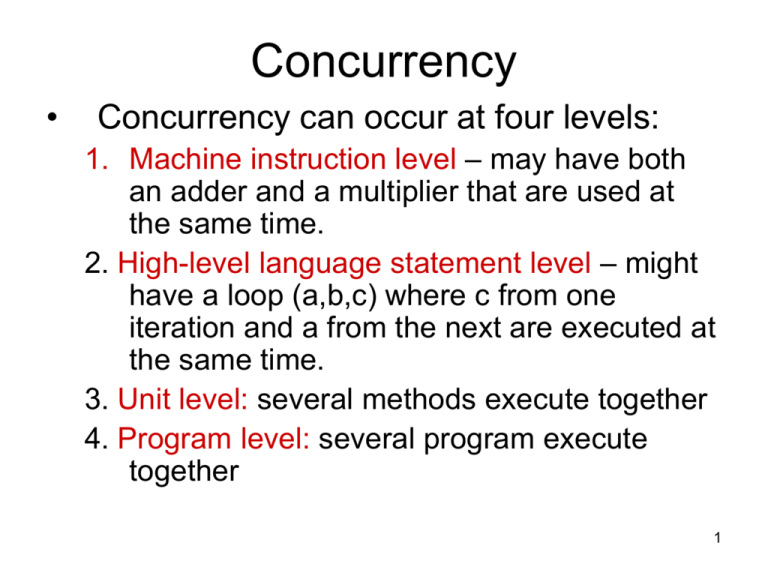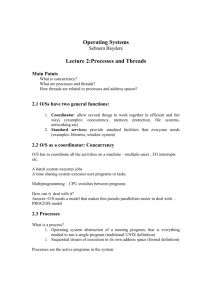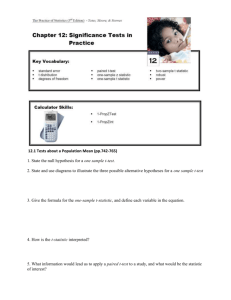Chapter 1
advertisement

Concurrency
•
Concurrency can occur at four levels:
1. Machine instruction level – may have both
an adder and a multiplier that are used at
the same time.
2. High-level language statement level – might
have a loop (a,b,c) where c from one
iteration and a from the next are executed at
the same time.
3. Unit level: several methods execute together
4. Program level: several program execute
together
1
Suppose we have two methods
Populate marsh{
for(i=0;i< 1000; i++){
create frog // high level language statement
create carp
create mosquitos}
}
Populate prehistoric world{
for (i=0;i<10,i++) create dinosaur(i)
}
2
Concurrency can occur at four levels
(termed granularity)
1. Machine instruction level – Create frog is
decomposed into basic parts. If one basic
instruction is to fold both sides into center,
perhaps one “processor” folds the left side
and one folds the right.
2. High-level language statement level different parts of “make frog” happen together
3. Unit level: populate marsh occurs with
populate prehistoric world
4. Program level: several programs (to do other
things not shown here) execute together
3
What would be the
advantages/disadvantages of
each type of parallelism?
4
The Evolution of Multiprocessor Architectures
1. Late 1950s - One general-purpose processor and one or
more special-purpose processors for input and output
operations
2. Early 1960s - Multiple complete processors, used for
program-level concurrency
3. Mid-1960s - Multiple partial processors, used for
instruction-level concurrency
4. Single-Instruction Multiple-Data (SIMD) machines. The
same instruction goes to all processors, each with different
data - e.g., vector processors
5. Multiple-Instruction Multiple-Data (MIMD) machines
• Independent processors that can be synchronized (unit-level
concurrency)
5
Making a Frog
Fold in sides
6
Take lower corner and
fold up to top. Repeat with
other side.
Fold into middle
Repeat
7
Examples
• SIMD - all do the same things at the same
time.
All fold; All Open; All fold again
• Pipelined – one person does fold, and
then passes. Problems?
• MIMD – all do different things
8
9
• Def: A thread of control in a program is the
sequence of program points reached as
control flows through the program
• Categories of Concurrency:
1. Physical concurrency - Multiple independent
processors (multiple threads of control)
2. Logical concurrency - The appearance of
physical concurrency is presented by timesharing one processor (software can be
designed as if there were multiple threads of
control)
10
What would be the advantage
of logical concurrency?
Consider the TV remote as performing
“context switch”.
Why does one switch between multiple
programs?
What is downside to switch?
Example: Smart Remote
Ads play when you are not
watching, assume “program”
doesn’t continue when you aren’t
watching it
• You might be an E-mail Junkie..
• You might be a computer science major
• Attraction to computer scientists
12
Concerns?
• Is switching between tasks confusing?
What would need to be retained?
• Is switching between tasks expensive?
Would there be a minimal size at which
you spawn more tasks?
• What is the gain?
13
• What is the gain?
– Models actual situation better
– response time
– Use delays in processing
14
Why do we want parallelism?
• Price-performance curves
• Used to be – paid more for computer - got
more (linear relationship between price
and performance).
• Now, for little money, get a lot of power. As
you add more money, performance curve
levels off. Not an efficient way to get more
performance
• Parallelism is the answer – string cheap
computers together to do more work.
15
What is a Thread ?
• Just as multitasking OS’s can run more than
one process “concurrently”, a process can do
the same by running more than a single
thread.
• Each Thread is a different stream of control
that can execute its instructions independently.
• Compared to a process, a thread is
inexpensive to create, terminate, schedule or
synchronize.
16
What is a Thread ?
• A process is a HEAVY-WEIGHT kernellevel entity. (process struct)
• A thread is a LIGHT_WEIGHT entity
comprising the registers, stack and some
other data.
• The rest of the process struct is shared by
all threads. (address space, file desc, etc.)
• Most of the thread structure is at the user
space allowing very fast access.
17
So for our example
• If we had two processes to populate the
marsh and to populate the prehistoric
world, each process would be able to
stand alone.
• If we had two threads to populate the
marsh and to populate the prehistoric
world, they would have some shared
resources (like the table or paper supply)
18
Concurrency Vs. Parallelism
• Concurrency means that two or more
threads can be in the “middle” of executing
code.
• Only one can be on the CPU though at
any given time.
• Parallelism actually involves multiple
CPUs running threads at the same time.
• Concurrency is the illusion of Parallelism
19
What can threads do that can’t be done
by processes sharing memory ?
• Answer: Nothing !... If you have
– plenty of time to kill programming,
– more time to kill processing,
– willing to burn money by buying RAM
• Debugging cross-process programs are tough.
• In Solaris creating a thread is 30 TIMES FASTER
than forking a process.
• Synchronization is 10 time faster with threads.
• Context Switching - 5 times faster
20
What Applications to Thread?
• Multiplexing (communicate two or more signals
over a common channel)
– Servers
• Synchronous Waiting (definition?)
– clients
– I/O
• Event Notification
• Simulations
• Parallelizable Algorithms
– Shared memory multiprocessing
21
– Distributed Multiprocessing
Which Programs NOT to
thread?
•
•
•
•
Compute bounds threads on a uniprocessor.
Very small threads (threads are not free)
Old Code
Parallel execution of threads can interfere
with each other.
• WARNING: Multithreaded applications are more
difficult to design and debug than single threaded
apps. Threaded programming design requires
careful preparation !
22
Synchronization
• The problem – Data Race - occurs when more than one thread
is trying to update the same piece of data.
– Critical Section - Any piece of code to which
access needs to be controlled.
• The Solution – Mutex
– Condition Variables
– Operations - init, lock, unlock
23
MUTEX
• A MUTual EXclusion allows exactly one
thread access to a variable or critical
section of code.
• Access attempts by other threads are
blocked until the lock is released.
24
• Kinds of synchronization:
1. Cooperation
– Task A must wait for task B to complete some
specific activity before task A can continue its
execution e.g., You cut the paper and then I fold it.
2. Competition
– When two or more tasks must use some resource
that cannot be simultaneously used e.g., we both
want the scissors.
25
• Liveness means the unit will eventually
complete its execution. I’m currently
blocked from finishing my frog, but I will
eventually get to finish.
• In a concurrent environment, a task can
easily lose its liveness. You were
supposed to wake me up when the
scissors became available, but you forgot.
• If all tasks in a concurrent environment
lose their liveness, it is called deadlock. I
take the paper and wait for the scissors.
You take the scissors and wait for the
paper. Circular wait is deadlock.
26
Livelock: theoretically can finish, but
never get the resources to finish.
How do you prevent deadlock?
How do you prevent livelock?
27
Questions?
28
• Methods of Providing Synchronization:
1. Semaphores
2. Monitors
3. Message Passing
29
Semaphores
• Dijkstra - 1965
• A semaphore is a data structure consisting of a
counter and a queue for storing task descriptors
• Semaphores can be used to implement guards
on the code (controlling access) that accesses
shared data structures
• Semaphores have only two operations, wait and
signal (originally called P and V by Dijkstra)
• Semaphores can be used to provide both
competition and cooperation synchronization
30
Example
• Suppose I was in a “frog
renting” business.
• I have a collection of
frogs.
• I keep track of my frogs
via a semaphore
• When you come to rent a
frog, if I have some, I just
adjust my semaphore
(count).
• If you come and I don’t
have one, I place you in a
queue.
frogAvail = 4
31
• Cooperation Synchronization with
Semaphores
– Example: A shared buffer – e.g., holding area for
frogs
– The buffer is implemented as an ADT with the
operations DEPOSIT and FETCH as the only
ways to access the buffer
– Use two semaphores for cooperation:
emptyspots (number of empty spots)
and fullspots (number of full spots)
32
• DEPOSIT must first check emptyspots to
see if there is room in the buffer (for a new
frog)
• If there is room, the counter of
emptyspots is decremented and the
value is inserted
• If there is no room, the caller is stored in
the queue of emptyspots (to wait for
room)
• When DEPOSIT is finished, it must
increment the counter of fullspots
33
• FETCH must first check fullspots to see
if there is an item
– If there is a full spot, the counter of
fullspots is decremented and the value is
removed
– If there are no values in the buffer, the caller
must be placed in the queue of fullspots
– When FETCH is finished, it increments the
counter of emptyspots
• The operations of FETCH and DEPOSIT on
the semaphores are accomplished through
two semaphore operations named wait and
signal.
34
Semaphores
wait(aSemaphore)
if aSemaphore’s counter > 0 then
Decrement aSemaphore’s counter
else
Put the caller in aSemaphore’s queue
Attempt to transfer control to some
ready task
end
35
Semaphores
signal(aSemaphore)
if aSemaphore’s queue is empty then
Increment aSemaphore’s counter
else
Put the calling task in the task ready
queue
Transfer control to a task from
aSemaphore’s queue
end
36
Producer Code
semaphore fullspots, emptyspots;
fullstops.count = 0;
emptyspots.count = BUFLEN;
task producer;
loop
-- produce VALUE –wait (emptyspots); //wait for space
DEPOSIT(VALUE);
signal(fullspots);//increase filled
end loop;
end producer;
37
Consumer Code
task consumer;
loop
wait (fullspots); //wait till not empty
FETCH(VALUE);
signal(emptyspots); //increase empty
-- consume VALUE –end loop;
end consumer;
38
Competition Synchronization with Semaphores
– A third semaphore, named access, is used to
control access to buffer itself as trying to produce
and consume at same time may be problem
(competition synchronization)
• The counter of access will only have the values 0
and 1
• Such a semaphore is called a binary semaphore
– Note that wait and signal must be atomic!
39
Producer
Code
access, fullspots,
semaphore
emptyspots;
access.count = 0;
fullstops.count = 0;
emptyspots.count = BUFLEN;
task producer;
loop
-- produce VALUE –wait(emptyspots); //wait for space
wait(access);
//wait for access
DEPOSIT(VALUE);
signal(access); //relinquish access
signal(fullspots); //increase filled
end loop;
40
end producer;
Consumer Code
task consumer;
loop
wait(fullspots);//wait till not empty
wait(access);
//wait for access
FETCH(VALUE);
signal(access); //relinquish access
signal(emptyspots); //increase empty
-- consume VALUE –end loop;
end consumer;
41
Semaphores
• Evaluation of Semaphores:
1. Misuse of semaphores can cause failures in
cooperation synchronization, e.g., the buffer
will overflow if the wait of fullspots is left
out
2. Misuse of semaphores can cause failures in
competition synchronization, e.g., the
program will deadlock if the release of
access is left out
42
Monitors
• Concurrent Pascal, Modula, Mesa, Java
• The idea: encapsulate the shared data
and its operations to restrict access
• A monitor is an abstract data type for
shared data
43
Monitor Buffer Operation
44
Monitors
• Evaluation of monitors:
– Support for competition synchronization is
great. Less chance for errors as system
controls.
– Support for cooperation synchronization is
very similar as with semaphores, so it has the
same problems
45
Message Passing
• Message passing is a general model for
concurrency
– It can model both semaphores and monitors
– It is not just for competition synchronization
• Central idea: task communication is like
seeing a doctor--most of the time he waits
for you or you wait for him, but when you
are both ready, you get together, or
rendezvous (don’t let tasks interrupt each
46
other)
Message Passing
• In terms of tasks, we need:
a. A mechanism to allow a task to indicate when
it is willing to accept messages
b. Tasks need a way to remember who is waiting
to have its message accepted and some “fair”
way of choosing the next message
• Def: When a sender task’s message is
accepted by a receiver task, the actual
message transmission is called a
rendezvous
47
Thank You!
48
Java Threads
• Competition Synchronization with Java
Threads
– A method that includes the synchronized
modifier disallows any other method from
running on the object while it is in execution
– If only a part of a method must be run without
interference, it can be synchronized
49
Java Threads
• Cooperation Synchronization with Java
Threads
– The wait and notify methods are defined
in Object, which is the root class in Java, so
all objects inherit them
– The wait method must be called in a loop
50
• Basic thread operations
– A thread is created by creating a Thread or
Runnable object
– Creating a thread does not start its concurrent
execution; it must be requested through the
Start method
– A thread can be made to wait for another
thread to finish with Join
– A thread can be suspended with Sleep
51
C# Threads
• Synchronizing threads
– The Interlock class
– The lock statement
– The Monitor class
• Evaluation
– An advance over Java threads, e.g., any method
can run its own thread
– Thread termination cleaner than in Java - abort
– Synchronization is more sophisticated
52
Message Passing
Concepts: synchronous message passing - channel
asynchronous message passing - port
- send and receive / selective receive
rendezvous bidirectional communications - entry
- call and accept ... reply
Models: channel
port
entry
: relabelling, choice & guards
: message queue, choice & guards
: port & channel
Practice: distributed computing (disjoint memory)
threads and monitors (shared memory)
53
Synchronous Message Passing
- channel
Sender
send(e,c)
Channel c
one-to-one
send(e,c) - send the
value of the expression e
to channel c. The process
calling the send
operation is blocked until
the message is received
from the channel.
Receiver
v=receive(c)
v = receive(c) - receive a
value into local variable v
from channel c. The process
calling the receive operation
is blocked waiting until a
message is sent to the
channel.
cf. distributed assignment v = e
54
Demonstration of Channel
• Try to pass all objects to final destination
• To send- hold out object, but must be
taken before you can do anything else.
• Advantages? Disadvantages?
55
synchronous message passing applet
A sender
communicates
with a receiver
using a single
channel.
The sender
sends a
sequence of
integer values
from 0 to 9
and then
restarts at 0
again.
Instances of
ThreadPanel
Channel chan = new Channel();
tx.start(new Sender(chan,senddisp));
rx.start(new
Receiver(chan,recvdisp));
Instances of
SlotCanvas
56
Java implementation - channel
class Channel extends Selectable {
Object chann = null;
public synchronized void send(Object v)
throws InterruptedException {
chann = v;
signal();
while (chann != null) wait();
}
public synchronized Object receive()
throws InterruptedException {
block(); clearReady();
//part of
Selectable
Object tmp = chann; chann = null;
notifyAll();
//could be
notify()
return(tmp);
}
57
Java implementation - sender
class Sender implements Runnable {
private Channel chan;
private SlotCanvas display;
Sender(Channel c, SlotCanvas d)
{chan=c; display=d;}
public void run() {
try { int ei = 0;
while(true) {
display.enter(String.valueOf(ei));
ThreadPanel.rotate(12);
chan.send(new Integer(ei));
display.leave(String.valueOf(ei));
ei=(ei+1)%10;
ThreadPanel.rotate(348);
}
} catch (InterruptedException e){}
58
}
}
Java implementation - receiver
class Receiver implements Runnable {
private Channel chan;
private SlotCanvas display;
Receiver(Channel c, SlotCanvas d)
{chan=c; display=d;}
public void run() {
try { Integer v=null;
while(true) {
ThreadPanel.rotate(180);
if (v!=null)
display.leave(v.toString());
v = (Integer)chan.receive();
display.enter(v.toString());
ThreadPanel.rotate(180);
}
} catch (InterruptedException e){}
}
}
59
selective receive
Sender
c1
Sender
send(e,c)
c2
Sender[n]
send(e,c)
cn
send(en,cn)
Select
statement...
Channels
How
should we deal
with multiple
channels?
select
when G1 and v1=receive(chan1)
=> S1;
or
when G2 and v2=receive(chan2)
=> S2;
or
when Gn and vn=receive(chann)
=> Sn;
60
selective receive
CARPARK
ARRIVALS
arrive
CARPARK
CONTROL
depart
DEPARTURES
61
Asynchronous Message
Passing - port
Port
p
Sender
Sender
Sender[n]
send(e,c)
send(e,c)
send(en,p)
Receiver
v=receive(p)
many-toone
send(e,c) - send the
value of the expression e
to port p. The process
calling the send operation
is not blocked. The
message is queued at the
port if the receiver is not
waiting.
v = receive(c) receive a value into local
variable v from port p.
The process calling the
receive operation is
blocked if there are no
messages queued to the62
port.
asynchronous message passing
applet
Two senders
communicate
with a receiver
via an
“unbounded”
port.
Each sender
sends a
sequence of
integer values
from 0 to 9
and then
restarts at 0
again.
Instances of
ThreadPanel
Port port = new Port();
tx1.start(new
Asender(port,send1disp));
tx2.start(new
Asender(port,send2disp));
rx.start(new Instances of
Areceiver(port,recvdisp));
SlotCanvas
63
Java implementation - port
class Port extends Selectable {
Vector queue = new Vector();
The
implementation
of Port is a
public synchronized void send(Object v){
monitor that
queue.addElement(v);
has
signal();
synchronized
}
access methods
public synchronized Object receive() for send and
throws InterruptedException { receive.
block(); clearReady();
Object tmp = queue.elementAt(0);
queue.removeElementAt(0);
return(tmp);
}
}
64
Rendezvous - entry
Rendezvous is a form of request-reply to support
client server communication. Many clients may
request service, but only one is serviced at a time.
Client
Server
res=call(entry,req)
Request
message
suspended
req=accept(entry)
perform service
Reply
message
reply(entry,res)
65








